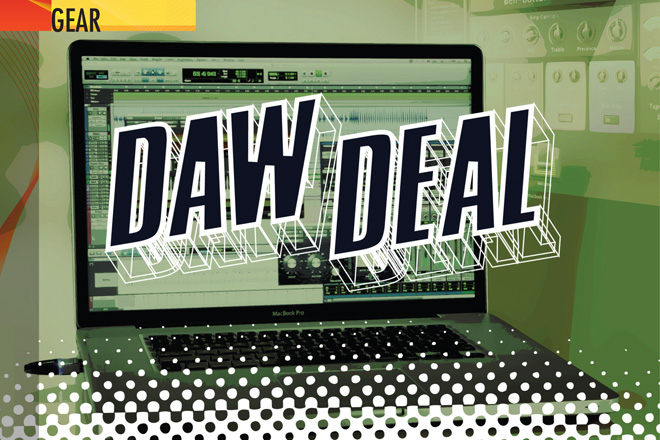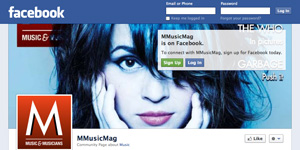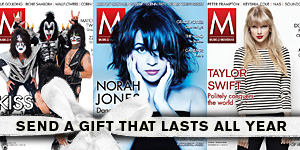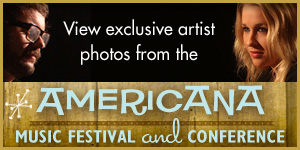DAW DEAL
Digital Audio Workstations can help you make a masterpiece—if you use them correctly
For decades making a record meant big studios, big budgets and countless feet of analog tape—but all that has changed. Today nearly any musician can get access to a computer and the necessary software required to craft an entire album in the comfort of his or her own home. So what exactly is this powerful software that makes the magic happen? The studio-in-a-box Digital Audio Workstation—better known as DAW.
Using the right DAW can open up enormous creative possibilities. But with so many software packages available—and the many differences among them ranging from obvious to arcane—how do you know which one is right for you and your project? We turned to two experts to help us break down the complex world of DAWs. Mitch Gallagher is a Grammy-winning composer, technology journalist/author and editorial director for Sweetwater Sound. Mark Hornsby is a Nashville producer and engineer who has worked with artists like Dolly Parton, the Judds and Travis Tritt. Hornsby, a certified Pro Tools expert, is also a software development consultant for noted music technology companies.
What basic features do different DAWs have in common?
GALLAGHER: All DAWs include the components you need to record, edit, process, mix and finish a music or audio production from beginning to end. All you need in addition to the software is a way to get sound in and out of the computer and a way to listen. They take the place of a large recording studio and the gear it would include.
HORNSBY: They all include those basic features—recording, playback, editing—but in different ways. Once you get past that and start to get specialized, then things change.
What are the most dominant DAWs?
HORNSBY: Avid Pro Tools and Apple Logic are the two majors I see. I also know a lot of arrangers who like to use MOTU Digital Performer. Ableton Live is a different beast, but it’s very popular.
GALLAGHER: You also have Steinberg Cubase and Nuendo, Cakewalk Sonar and some newer ones like PreSonus Studio One and Capture, and Propellerheads Reason 6, which is a little different.
How are Live and Reason different?
HORNSBY: In simple terms, Live is focused on looping audio and moving stuff around on the fly without interrupting playback. DJs and live performers love it because you can control and tweak in real time while onstage. I’ve always been impressed by Live. It wouldn’t be my go-to program for recording or editing, though.
GALLAGHER: Reason started out as music creation software with virtual synths, samplers and drum machines. You could make beats and loops, but for years you couldn’t record audio, so basically you were making backing tracks. Now it has the ability to record all the tracks you want in audio, too.
HORNSBY: Reason is a very good tool with lots of different sound libraries, and it doesn’t bog down your computer badly like other programs can. It’s also pretty simple and intuitive to learn.
How about the others?
GALLAGHER: Pro Tools has taken a traditional recording studio approach from the beginning, and that’s something a lot of engineers find very comfortable to work with. It’s incorporated a lot of musician-friendly features as well, but the classic studio vibe has really been its focus.
HORNSBY: If your goal is specifically to engineer audio, then compatibility is important—and Pro Tools offers that. There’s not a rentable commercial recording studio out there that does not have a Pro Tools system. If you’re a keyboard player and you want to record lots of orchestrations with software synths, then Logic might be more user-friendly. That program has had MIDI and sequencing down for a long time and has the capability to do more advanced MIDI editing. Plenty of consumers use Cubase, and on a pro level it pops up every once in a while—Kelly Clarkson’s My December was all cut in Cubase. I used Nuendo for a little while and it felt like, for lack of a better term, a more professional and expandable version of Cubase. Michael Wagener does a lot of work mixing hard-rock records for Metallica, Skid Row and Ozzy Osbourne on Nuendo. Chuck Ainlay mixes Mark Knopfler records in Nuendo, too. But both use it as a tape machine. They’re using a recording console to mix and not doing it completely inside the computer, like many do with Pro Tools.
What’s good for film scoring?
GALLAGHER: Digital Performer is very strong in that world, as is Pro Tools. They have features for synchronization and spotting that make video easy to work with. Most DAWs will let you import video, so if you’re doing a band DVD you can drop in video directly. But Performer and Pro Tools are the two that seem to be used most often in Hollywood.
HORNSBY: I watched a session where Danny Elfman was scoring Alice in Wonderland in Digital Performer. A lot of the synth pad sounds in that movie were software synths recorded in Performer. There’s a good group of people who use it, especially if they want to do serious MIDI programming.
Does one brand sound better or different from another?
HORNSBY: On a very technical level I could make an argument that different DAWs sound different. But on a practical level, nobody’s going to say that any DAW does a bad job. Different environments lead you to make different creative decisions when you record, mix or edit, so it’s pointless to compare them side by side. However, the mics, preamps and converters you use are a huge part of this—and your sound is only as good as its weakest link.
So how do you choose one?
GALLAGHER: Sometimes these programs get pigeonholed—this DAW is the only one that works for musicians, or this one is only a film-scoring program. But that’s not the case. They all work with virtual instruments. They all have audio tracks and plenty of processing, so no matter what you’re doing the program can probably handle it. The question is, are you comfortable working in that platform and do you like the user interface? If you want to try different ones out, some DAWs have “light” versions that may have less tracks or features, but are affordable ways to test the waters. Some also have free demos that you can download.
How can one learn to better use DAWs?
HORNSBY: The elements of a DAW—the mixer, the waveform, the audio effects—all of this stuff didn’t just appear out of nowhere. These programs were originally based on fundamentals in technology that have been used to make records for the last 50 years. The principles that were used to record the Beatles and Pink Floyd on analog tape are the same as they are now. They’re just being expressed in a computer environment. So if people are serious about wrapping their heads around these programs, I recommend backing up and learning where recording technology principles came from first.
GALLAGHER: There are lots of tutorial videos available online, but there’s no substitute for using the program and challenging yourself to learn its features. Some use programs for years and still don’t know key commands and shortcuts—features that would make their lives easier. It can be painful, but spending time with the manual can help. You want to know the program well enough that it becomes transparent. If you don’t, then it takes away from making music.
HORNSBY: The more you understand about how your computer operates, where and how it stores files and such, the better off you’ll be. Anything that helps you make better technical decisions helps you make better recordings.
–Michael Gallant




comment closed